BILL'S
[Somewhat] WEEKLY COLUMN/BLOG PAGE
BILL’S BACK IN TIME
By Bill Ladabouche
A Historic Day in
JACKsonville
The Jacksonville 100, a short Grand National race held late in the 1963 NASCAR
season, was hugely historic in so many ways. Firstly ,and most importantly, we
who have learned about Wendell Scott, the pioneering African – American stock
car driver from Danville, Virginia, know that he won this race but was not given
credit for it until later- after all of the fans and media had left the grounds.
Although the movie “Greased Lightning”, a loosely – accurate story of Scott's
struggles as a stock car driver in a predominantly white, red neck sport in the
South does address this miscarriage of justice, they have it at a late model
sportsman race. They have him winning a big superspeedway race, later, crossing
the finish line with one wheel coming off the car. Most of that was bull crap.
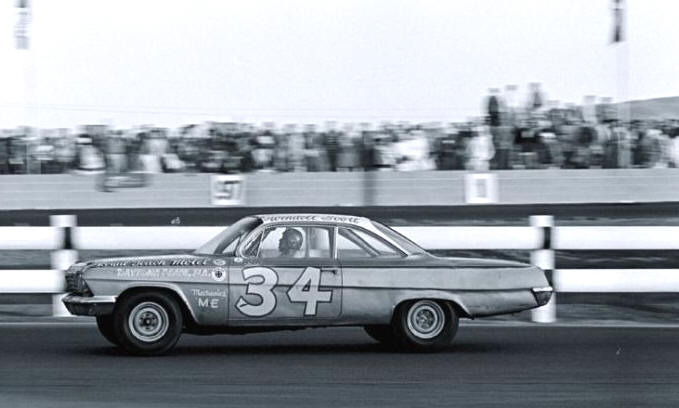
HOT ROD Magazine Photo
Courtesy of Andy Towler
Very likely, the
same car he used to win at Jacksonville. Below – Wendell worked as hard as any
low level crew member on any team; and he had to do it before and after driving
the hot, ill-handling car for hundreds of laps.
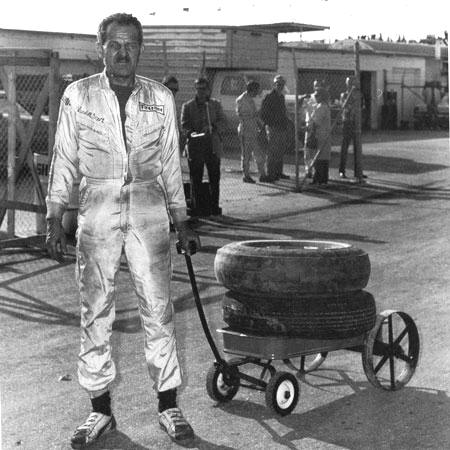
Courtesy of Lew Boyd
The 100 miler on an apparently rough dirt track at the Jacksonville, Florida.
Several top runners fell out of the race with technical issues consistent with a
very rough surface: Jimmy Pardue, broken axle; Lee Roy Yarbrough, broken axle;
Larry Frank – broken wheel; David Pearson, hole in the oil pan; and the Wild
Indian, Roy Tyner – another broken axle. The other car out of the race with
track – related damage was my friend and former Catamount driver, Jack Anderson,
who suffered a a hole in the radiator.
Anderson's participation in this race was likely due to an effort by NASCAR to
scrape together a field for one of their smaller races; but his being there for
the Scott victory and subsequent Victory Lane screw job puts him on the ground
floor of one of racing's more important historical events. Jack belongs to the
Living Legends of Auto Racing and regularly rubbed shoulders with the likes of
Ray Fox and David Pearson. Jack tried a little of everything for NASCAR: Grand
Nationals, Grand Touring, Baby Grands, late model sportsman, and likely more.
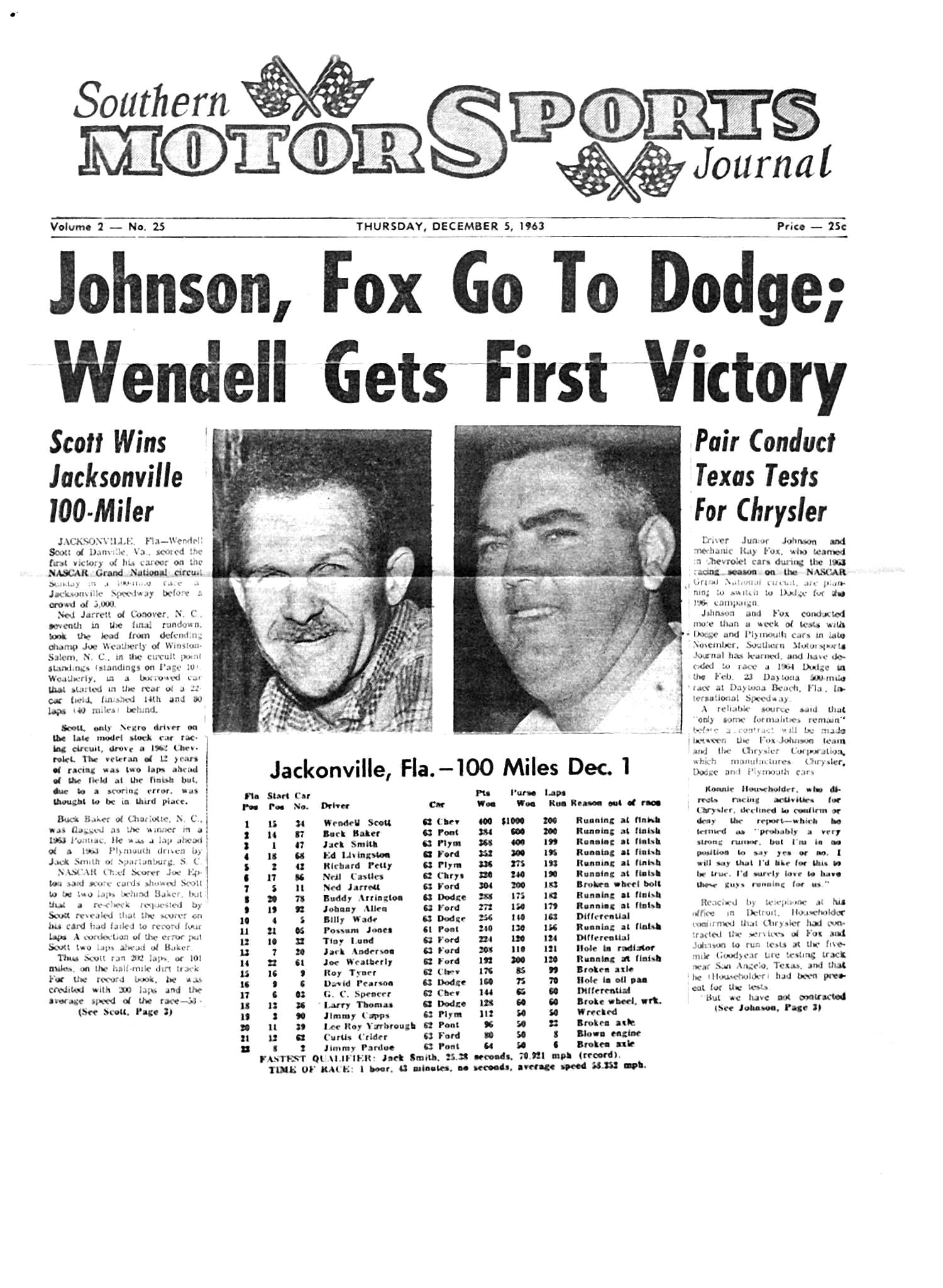
Because it is hard to read, I am putting a
thumbnail below with a link to the bigger - sized image of this paper.
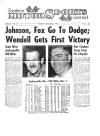
Courtesy of Jack Anderson
The Southern
Motor Sports Journal bravely told the truth [sort of] about the Scott win in
Jacksonville. They had to be careful if they ever wanted Big Bill France to let
them into another race. Below - Jack Anderson [rt] sits at a JRA banquet with
fellow Catamount late model driver Dave Dion, another member of LLOAR.
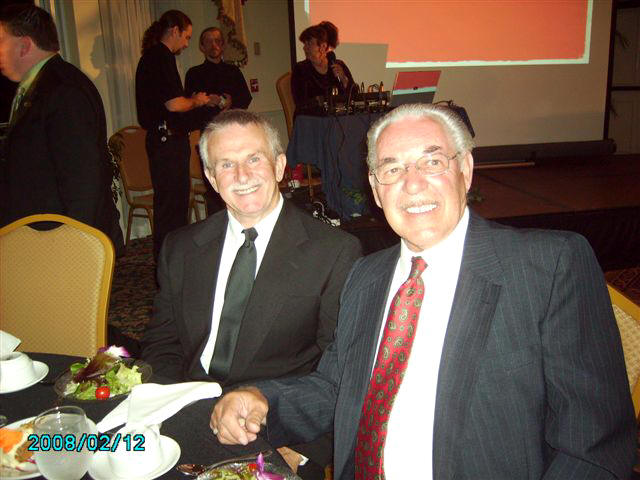
Courtesy of Jack Anderson
To get back to the race, the results and all of the controversy about how the
scoring was handled came from The Southern
Motors Sports Journal, which I give a lot
of credit for bravery seeing as almost everyone was content to sweep the whole
Scott thing under any rug they could find. According to the Journal, Scott had
actually finished about two laps ahead of the next driver, having actually
completed more than the required laps of the race. The article says that one of
the scorers, in failing to hold up his card for the chief scorers to see one
time, was responsible for this mess. An inadvertent error ? I bet.
In the movie, a sheepish official walks out to the gate, where the Scotts are
sitting, fuming, and hands Wendell his trophy. Scott always maintained he
received a second rate [and somewhat damaged] trophy in the mail the following
week. Talk about buzz kill ! The article is nice enough; although Scott gets a
sort of second billing to Junior Johnson and Ray Fox moving over to Chrysler and
doing some testing. Wendell got a big photo next to an equally big one of
Junior.
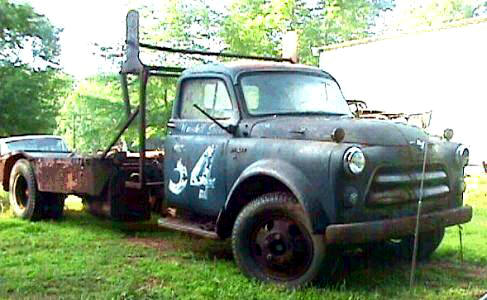
Courtesy of ThunderPlex.Com
Two shots of the
pampered conditions under which Wendell Scott went about Grand National racing.
Below -
Wendell takes a break to get away from the dozens of highly - paid, bustling
technicians working around his race shop in Danville, VA. [not].
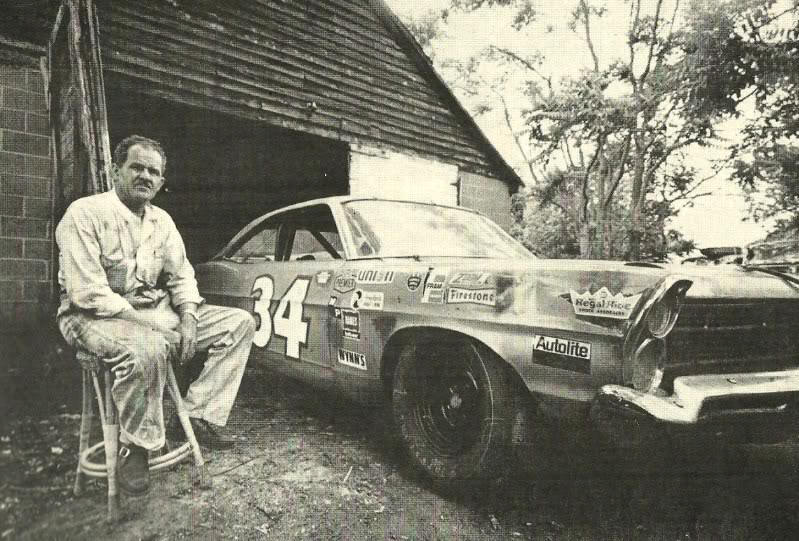
Source Unknown
The Jacksonville race was, as I mentioned, very small when compared to something
like the Southern 500 or Daytona. There were 22 cars there, with the major teams
needing to show up for the points: Buck Baker, Richard Petty, Jimmy Pardue,
Billy Wade, David Pearson, Ned Jarrett, and points leader Joe Weatherly. Some
mid level [at that time] teams like Jack Smith, Lee Roy Yarbrough, Tiny Lund,
and Larry Thomas were in the field. The rest were guys like Anderson, Catfish
Crider, Possum Jones, Roy Tyner, G.C. Spencer, Jimmy Lee Capps, and more. Rookie
of the year candidate Bully Wade was there, as well. Within less than two years,
Wade, Weatherly, and Pardue would all be dead from racing accidents.
Wendell Scott would never again win a NASCAR Grand National race. Always running
on the leanest of budgets and always seemingly looking old and worn out, he
would field Fords mostly after his '62 Chevy became too old to campaign. He had
a 1965 Ford for as long he as he use it, and then a few other cars. At one big
Charlotte race, Charlotte furniture mogul Richard Howard set up Scott with what
was supposed to be a top flight ride for a big race, The brown Howard Furniture
Monte Carlo didn't produce much for results, although I have no idea what the
circumstances were.
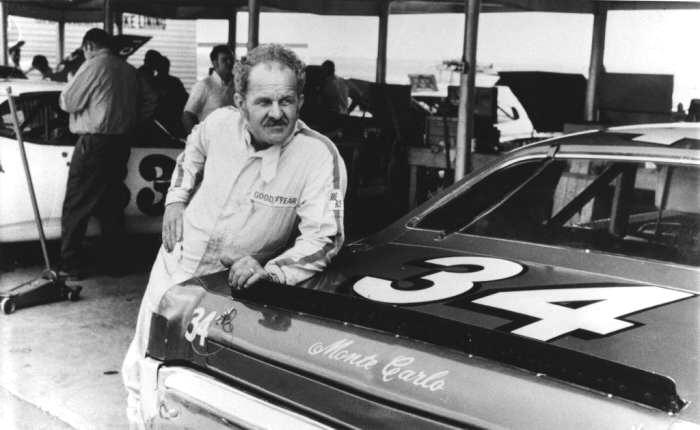
Courtesy of Jacksonville.Com
Wendell, looking
pensive in the garage area with the Howard Furniture Monte Carlo in Charlotte.
Below – He did apparently have a
better Ford for a while after the faithful 1965. For example this is one
he ran in Grand National East.
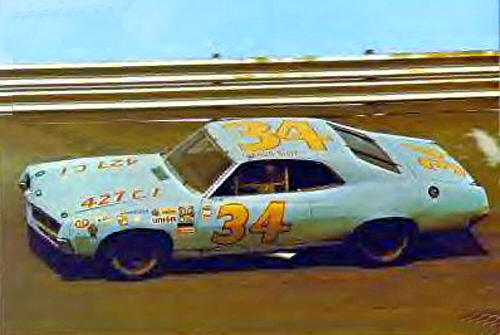
GrandNationalEast.Com Image
My fondest memory of Wendell is from back when the Grand Nationals did a long
[and unpopular among the drivers] Northern Tour in the summer; and Wendell was
in attendance at the race at Fonda Speedway. The tired looking pale blue #34
Ford appeared on the track for practice and Scott promptly inserted it into the
wooden barriers on the front stretch. The totally asymmetrical former horse
track [while fast for the local sportsman coupes] was an abomination to get used
to – particularly with a heavy, ungainly Grand National car.
In the grandstands at Fonda, the pits were then in the infield and you could see
a lot of the activity going on in there. As my friend Bob Allard said, “Ya could
see black guys running back and forth, all over the places, clutching borrowed
parts”. Well, Wendell didn't have much of a large crew, so those guys must have
been putting in some serious lap times. Sure enough, when time trials were
almost over, out limped a multi - color #34 and Scott managed an acceptable
time.
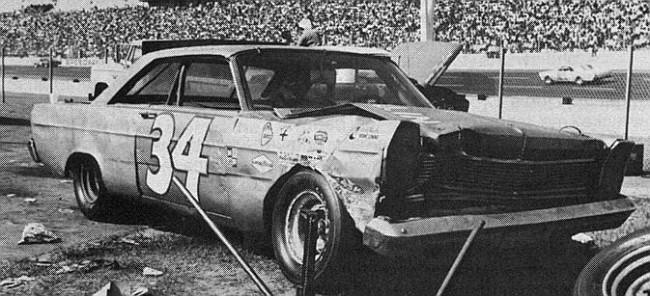 |
|
Courtesy of Andy Towler
The car at Fonda
probably didn't look this good. Below – It likely looked more like this. It had
been a long tour by then.
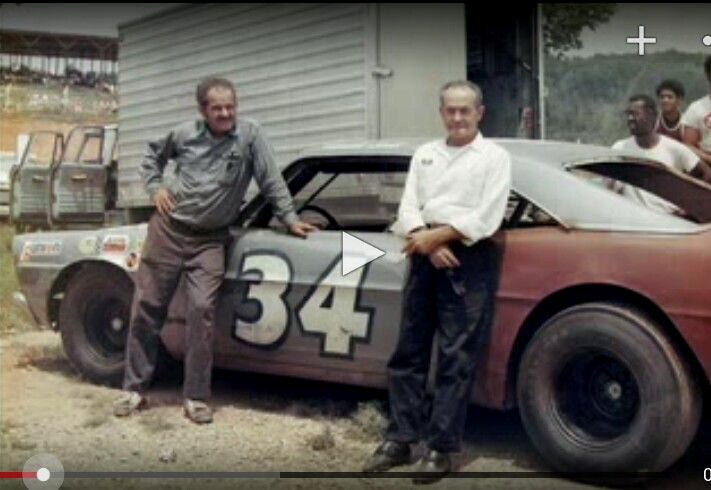
From Pinterest.com
Wendell managed to keep up and finished the race in something better than last
place. After the races were done, and knowing he had to go to work early the
next day, Bob insisted we go across to the infield to see the stars. Getting
over to Wendell's pit area, he told Scott [who was already busy working] that we
were big fans of his , from Vermont. “Oh yeah”, the tired driver said softly, “I
never heard of that – what state is Vermont in ?”
Seeing as Wendell Scott got into the Grand Nationals at a later age than the
average driver and that he had to do far more labor than the average driver, he
wore out after a while, just like his tired old equipment. He has received much
more positive attention since he stopped, but much of it came after his passing.
In looking at a promotional magazine pushing attendance at the upcoming [and
final Grand National race at Fonda, I saw where he rated one of the full page,
color portraits that were in the center of that publication. It was the least
they could, seeing as he was one of the more loyal supporters of the Northern
Tour.
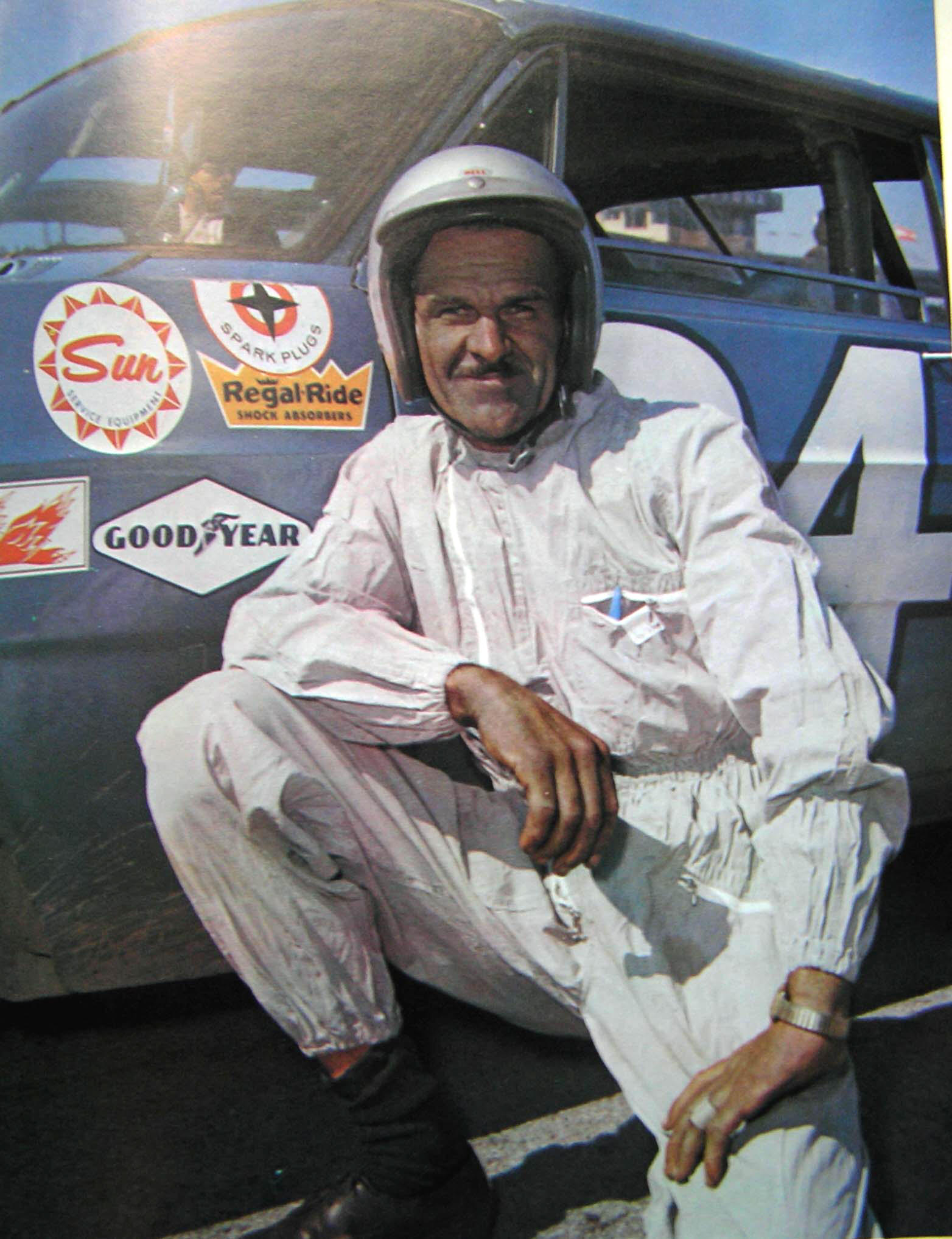
Racing Pictorial Photo 1966
Wendell poses for a
1966 Racing Pictorial portrait. The pen in the pocket of his driver's suit might
indicate his popularity, always ready for autographs. Below – leaning on a tired
– looking late '70's Ford. Many teams had a car for various track situations.
Wendell usually had A CAR.
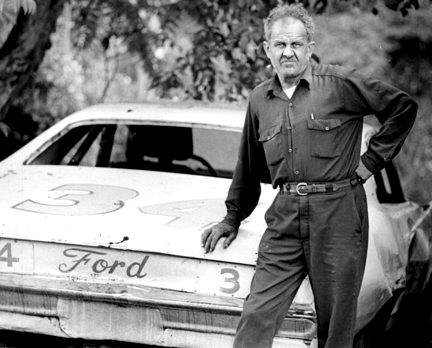
Courtesy of blog.al.com
As for Jack Anderson, I haven't seen him since around 2007, when he helped me
gather some rare family photos of local 1950's tracks in Chittenden County,
Vermont, at which he raced as a mere teenager. Starting at Ivahoe Smith's
Colchester Raceway, Anderson raced an old Nash coupe that rolled over on at
least one occasion. Colchester, Vt had at least five tracks within a two year
period in the early 1950's, and Jack told me he had raced on at least two of
them. [Some track managements were more fussy about driver age than others].
At the long, dusty, bumpy rural Otter Creek track, Jack had the chance to run
against the likes of then NASCAR 1961 National Sportsman Championsship
contenders Bill Wimble and Dick Nephew, as well as Kenny Shoemaker, Tom Kotary,
George Baumgardner, Paul Marshall, Dutch Reed, Roger Gauthier, Bob Bruno, Doc
Blanchard, Jim “Sapphire” LeClaire, and a host of other Fonda and Airborne
Speedway – based NASCAR sportsman drivers looking for easy national points at
that track.
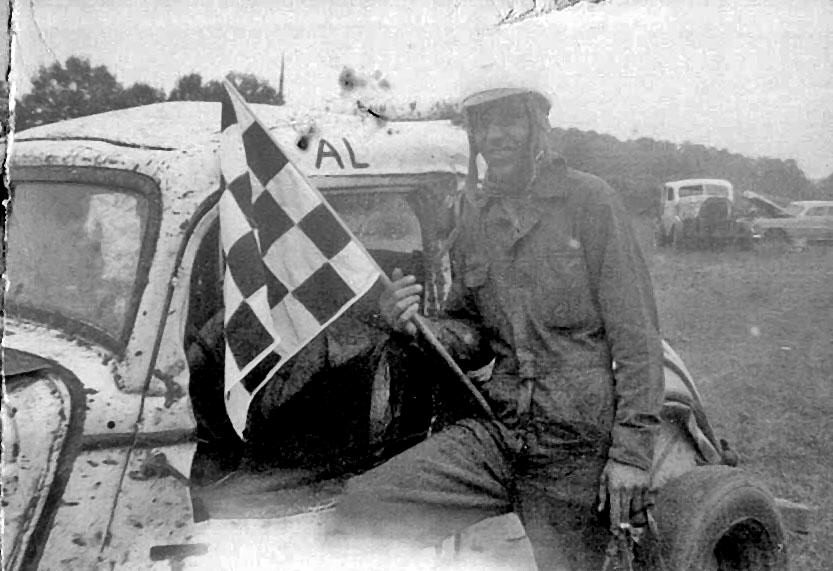
Courtesy of Jack Anderson
An underage Jack
Anderson, posing with a flag at Colchester Raceway around 1951. Below – Jack,
fifth car in black, is holding his
ground as Beaver Dragon [white coupe] and Jack Dubrul [1] are flying to the
front at Otter Creek Speedway in 1961.
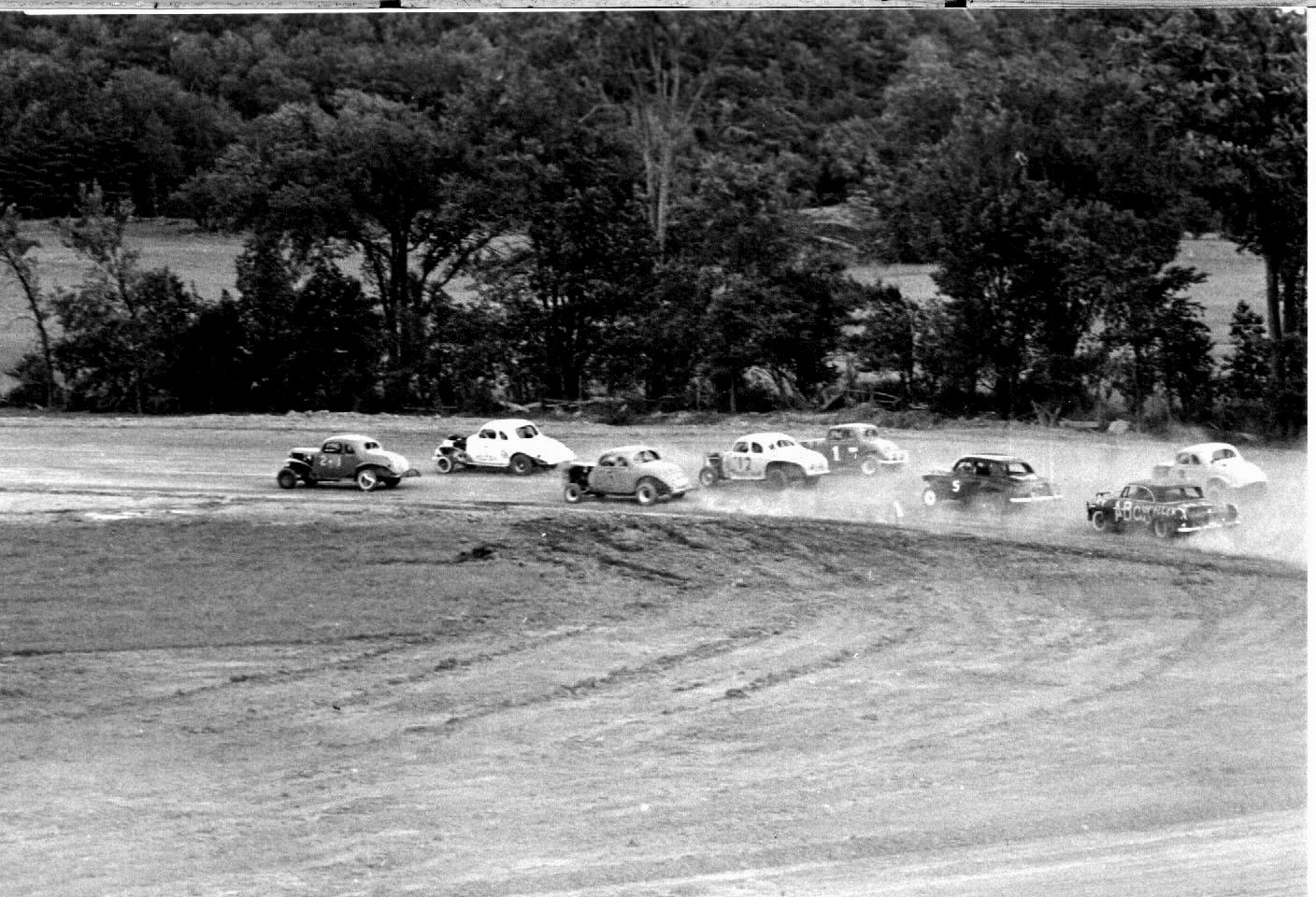
Courtesy of Cho Lee
Others in the hobby division at Otter Creek who competed with Anderson were
Harmon Beaver Dragon, a future hall of famer; Vince Quenneville, Sr, another
future hall of famer; Ed Foley, a future star at Lebanon Valley and Devil's
Bowl; and former 1950's stars like Rex Shattuck, Red Dooley, Wayne Chandler, and
others whom Anderson had raced with in the Colchester area. Jack would finish 13th
in the NASCAR hobby standings, his 44 points indicating he did not race often
there. While most of those drivers stayed with dirt, he, Dragon, and Sonny Gover
would all race at Catamount within four years.
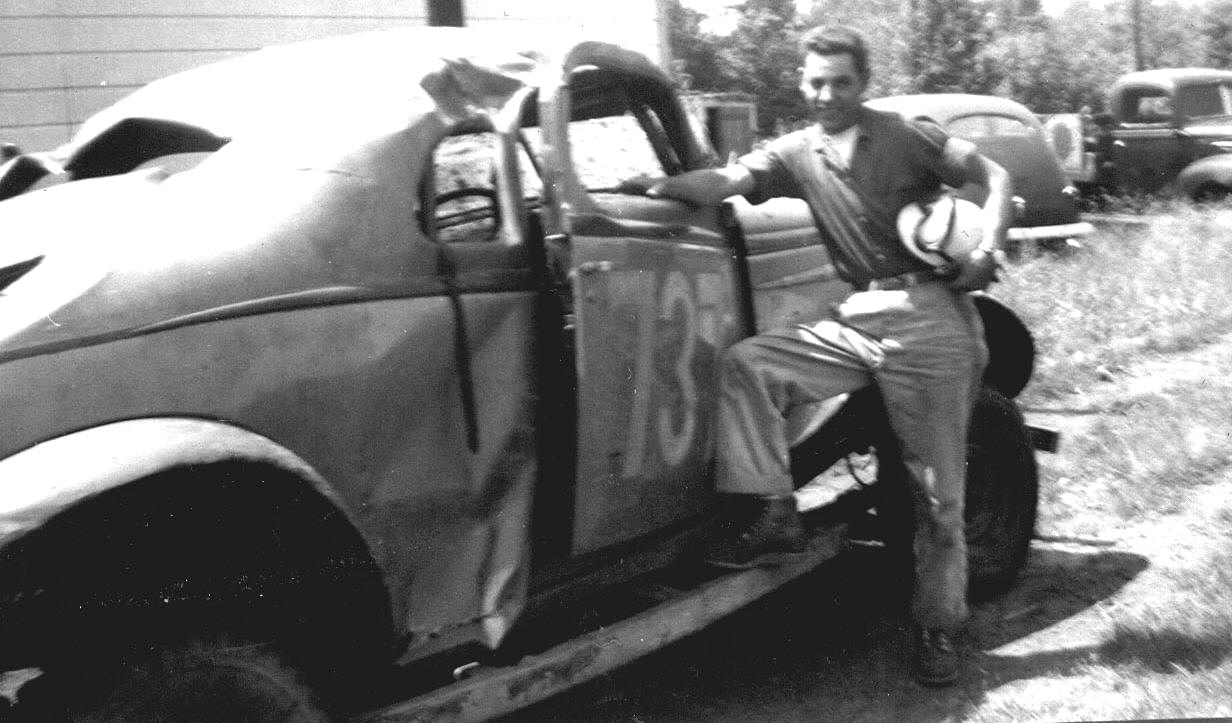
Courtesy of Jack Anderson
Jack says this Nash
was numbered 737 because, upside down, it was his owner's initials. Looks like
he tried out the theory. Below – The 1962 Hobby Division points from Otter
Creek. This is confusing because Jack ran only in 1961, as did Beaver, Herbie
Swan and Ansel Quintin; but this list came out in the 1962 book.
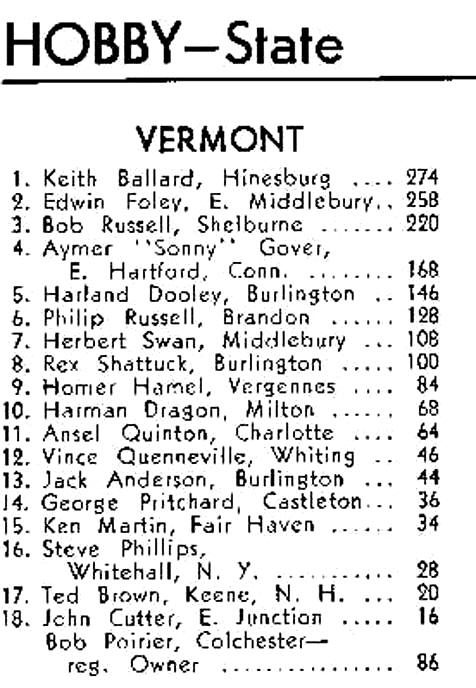
Courtesy of Gary Nephew
When
Catamount Stadium first opened in 1965, Jack would field a sportsman coupe with
the help of crew chief, Bill Boisvin, The #5 car bore the same number as a 1950
Chevy business coupe he had run a few times at the old NASCAR dirt track Otter
Creek Speedway. I don't know how much success he had running against established
pavement stars like Jean – Paul Cabana, Andre Manny, the Marcel “Mr. Clean”
Godard, Georges Loiselle, Ray Forte, Bob Bruno, Ernie Reid, Charlie Trombley,
and others, but I do know the coupe ended up wrecked hard enough to bend the
frame like a pretzel. Jack would head down South soon after.
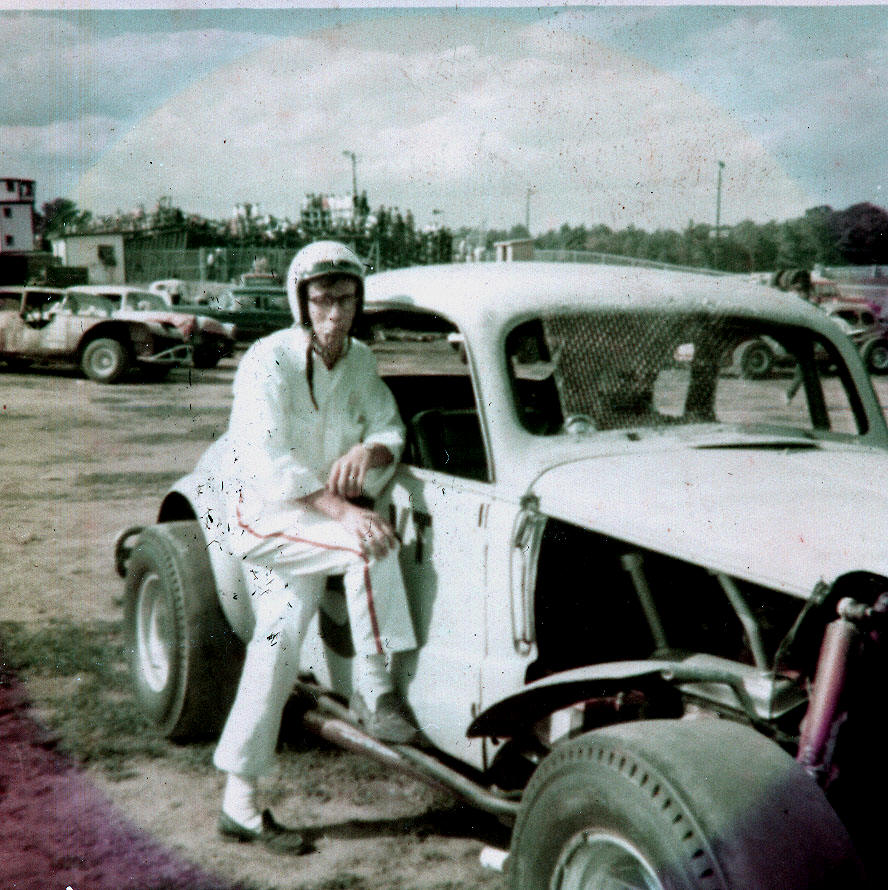
Courtesy of Jack Anderson
Crew Chief Bill
Boisvin poses with the sportsman coupe, perhaps while doing some test laps.
Below – It didn't need any more testing after this incident. Jack had tested it
enough. {Further Below] – Maybe Bill and Jack were on foot at Catamount just for
this reason.
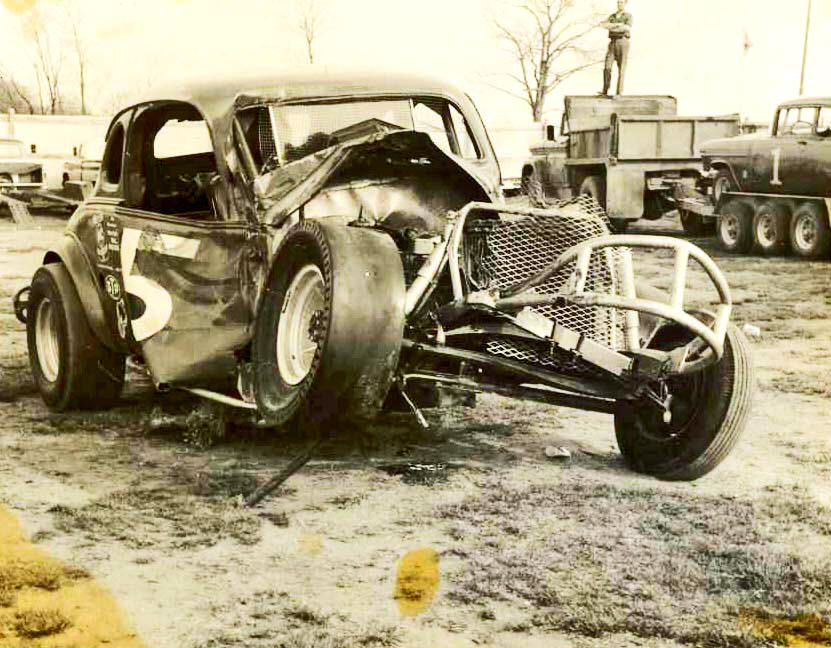
Courtesy of Jack Anderson
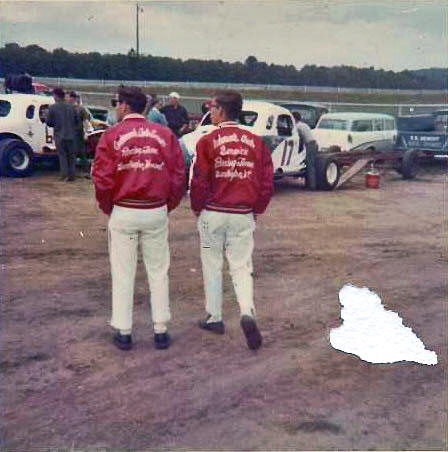
Courtesy of Jack Anderson
After some of the Southern adventures, Jack would arrive at Catamount and begin
racing again in the early 1970''s, having returned to operate a transmission
business on the north end of Burlington. While not knowing Jack then, I noticed
how fairly important people would gravitate towards his garage when they were
involved in racing at Catamount or Thunder Road.
Jack had a circle of unique characters such as local motor cycle club members
Phil {Super Hog] Bowler, Kenny Bucklin, Terry [Ox] Osterman, and others who
would end up helping out with not only local late model teams but with major
league teams down South. Bucklin could crew chief for just about anyone; the
huge Osterman could lift a full gas can like a Pepsi, and Bowler ? He was so
smart that straight-laced IMB put up with his long hair and beard for years in
the skinny tie and white shirt era. Anderson, Bowler, Osterman, Bucklin, and
Bucklin's father – in – law simply known as “Mr. Coke” formed one of the more
interesting groups to ever carve a niche in Northern NASCAR racing history.
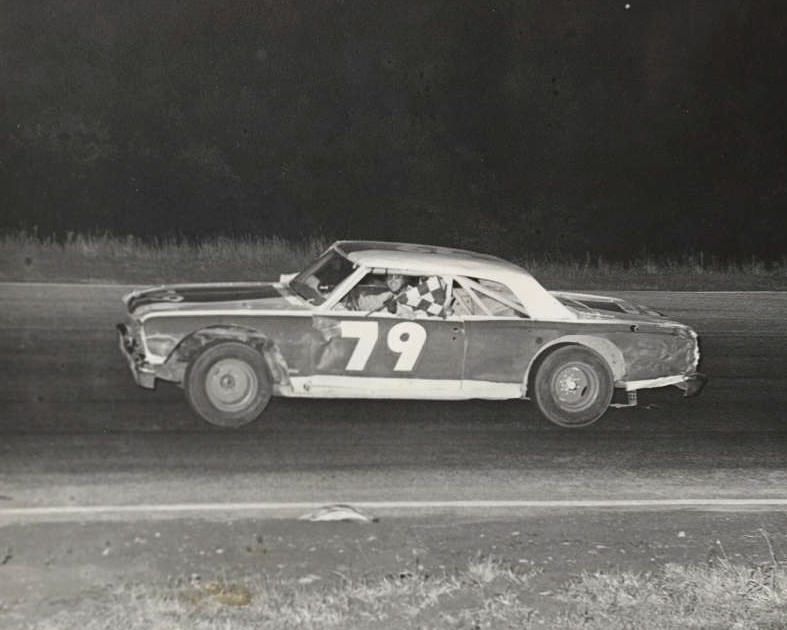
Courtesy of Jack Anderson
Jack takes one
with the wierd Chevelle, bearing Rene Maxfield's number, around 1972. Below -
The Super Hog bunch around Jack's car at Catamount. Bucklin [outside car in
driver suit[ had just qualified the car in Jack's absence. Phil Bowler is
kneeling and Mr. Coke is in the foreground.
The next car over [the 6 is showing] is the same car [different owner] that was
ripped off at Jack's a few months before.
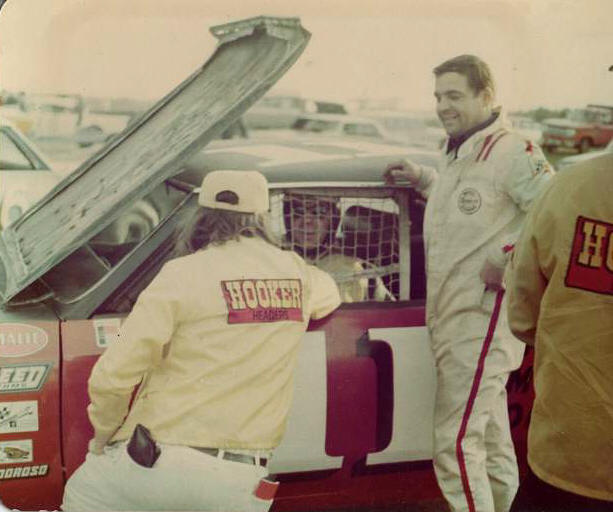
Courtesy of Jack Anderson
Jack once fielded the damnedest – looking late mode Chevelle with friend Rene
Maxfield. He finally explained what the hell made it so weird: it had started
out ads a convertible and they really didn't want to take forever getting some
other roof to fit onto it. [And it sort of didn't, really]. Jack would become
known for red and black #11 Chevelles at Catamount until either escalating costs
or moving back out of the area forced his departure.
Jack's tranny shop was not in the best area of Burlington, along Riverside
Avenue. He shared a building with the Road Chop Shop, the hangout for the Super
Hog club. Allen Pidgeon tells the story of the time that Austin Dickerman
[Brandon, VT used car dealer] had sent his late model sportsman up to be run at
Catamount. The Jean-Paul Cabana – built car had been sold to Catamount owner
[and driver] Jack Dubrul, who soon tired of it and sold it to Dickerman. All of
the Dickerman bunch were used to dirt; but Devil's Bowl had been paved and had
joined the Northern NASCAR late model circuit.
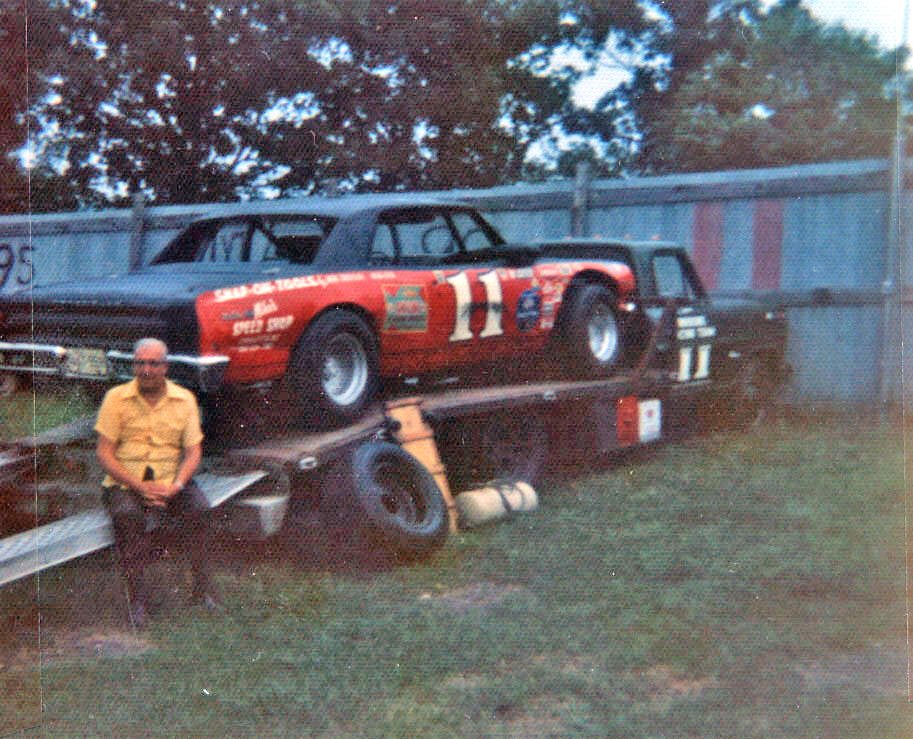
Ladabouche Photo
Although this is not
Jack's best – known late model, this is his favorite shot because I happened to
capture his dad during a rare visit to the races with Jack around 1973. Below –
A more typical Anderson LMS shot although he preferred red and black on this
car.
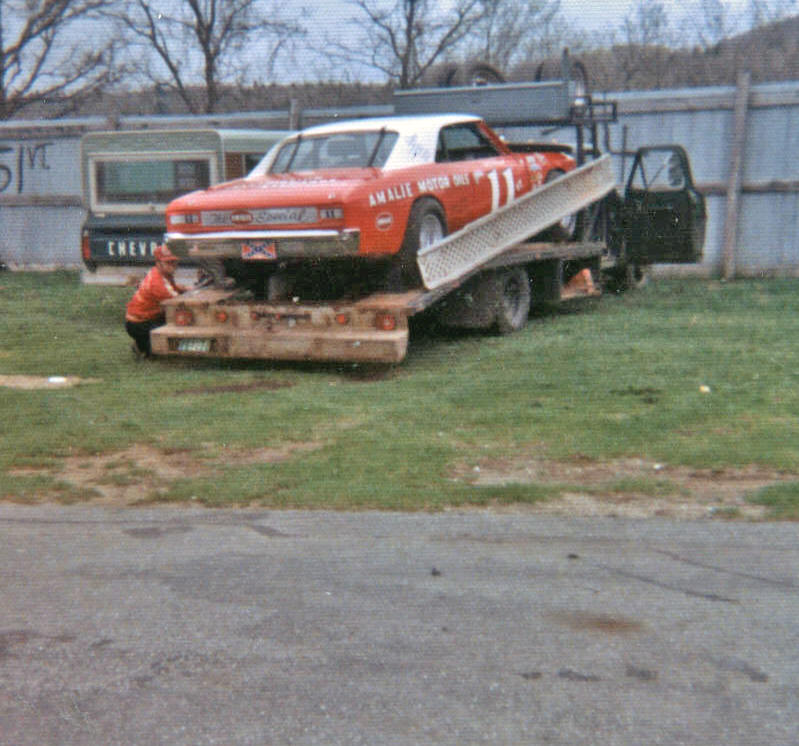
Ladabouche Photo
Dickerman had tried his old dirt star, Ed Foley, in the car; but Foley couldn't
make heads or tails of it. Pidgeon was to meet driver du jour the aforementioned
Marcel Godard up there to run the car that night. Pidgeon was part of a very
inexperienced and small crew. He described finding this pretty little driver
with a pink driving suit on. Oh Christ, he thought. While no one else had had
any luck with the banana yellow and light blue #57, Godard did [while
complaining about how badly it was set up] do a very creditable job driving the
Chevelle, according to Pidgeon..
Jack Anderson told Pidgeon and the others they could park the car at his garage
after they began to have trouble with the hauler after the races. Pidgeon said
they came back the next morning to find anything worth removing quickly gone
form the car. Dickerman nearly died from apoplexy; but Anderson assured him
nothing like that ever happened to him. [Of course not, who was going to rip off
a person connected to the Super Hogs?]
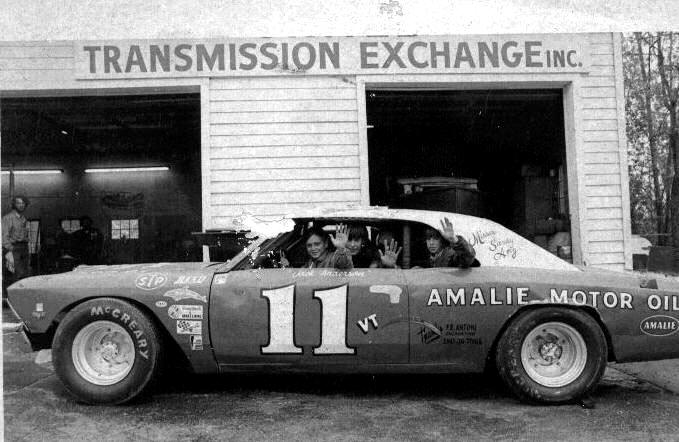
Courtesy of Jack Anderson
A group of what could be local
talent fills the car outside of Jack's transmission business on Riverside
Avenue. I wonder if Dickerman could have bought racing parts from any of these
guys. Below – While I don't have the car with Dickerman colors, this is
the same car that was ripped off at Jack's that night.
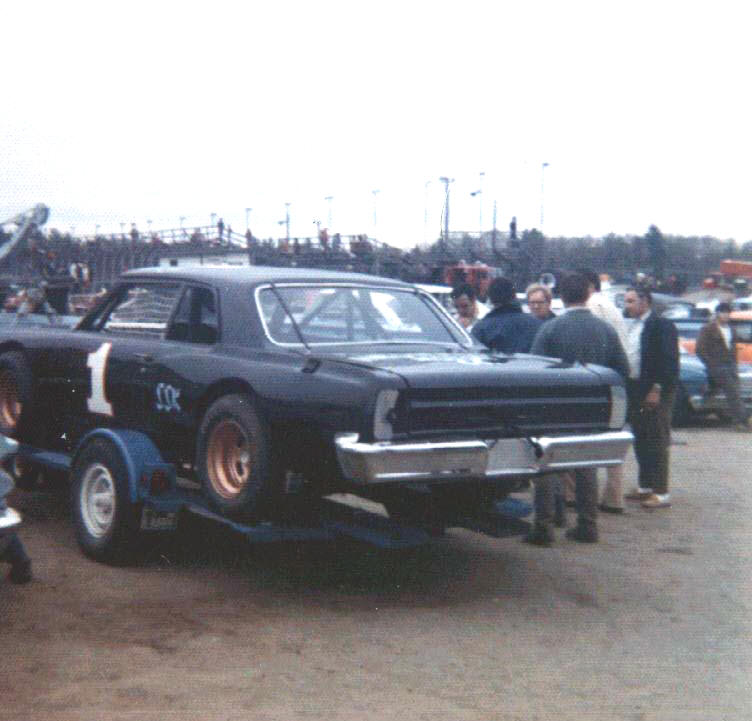
Ladabouche Photo
I haven't been able to ask Jack much about the rest of his career, but I know
that – much like Vermont native Paul Connors – he did experiment with an entry
in the Grand Touring division. The car was connected with Jim Vandiver [van – di
veer], who drive in that division, the Grand National East, and in the regular
Grand National division. Jack's photos show that he also threw in with another
of NASCAR's short – loved upper leagues ideas, the Baby Grands.
The Baby Grands featured small four cylinder brands of cars whose races were to
supplement Grand National programs much in the same way as ARCO, the Trucks. or
the Xfinity series would work in today's world. The idea never caught on much,
as most hardcore NASCAR fans loved the roar of muscle cars, not the whine of
little four bangers. Anderson would campaign a Pinto in some of these races for
a while before, I think, he decided to come back North and do the model thing
along with the tranny garage.
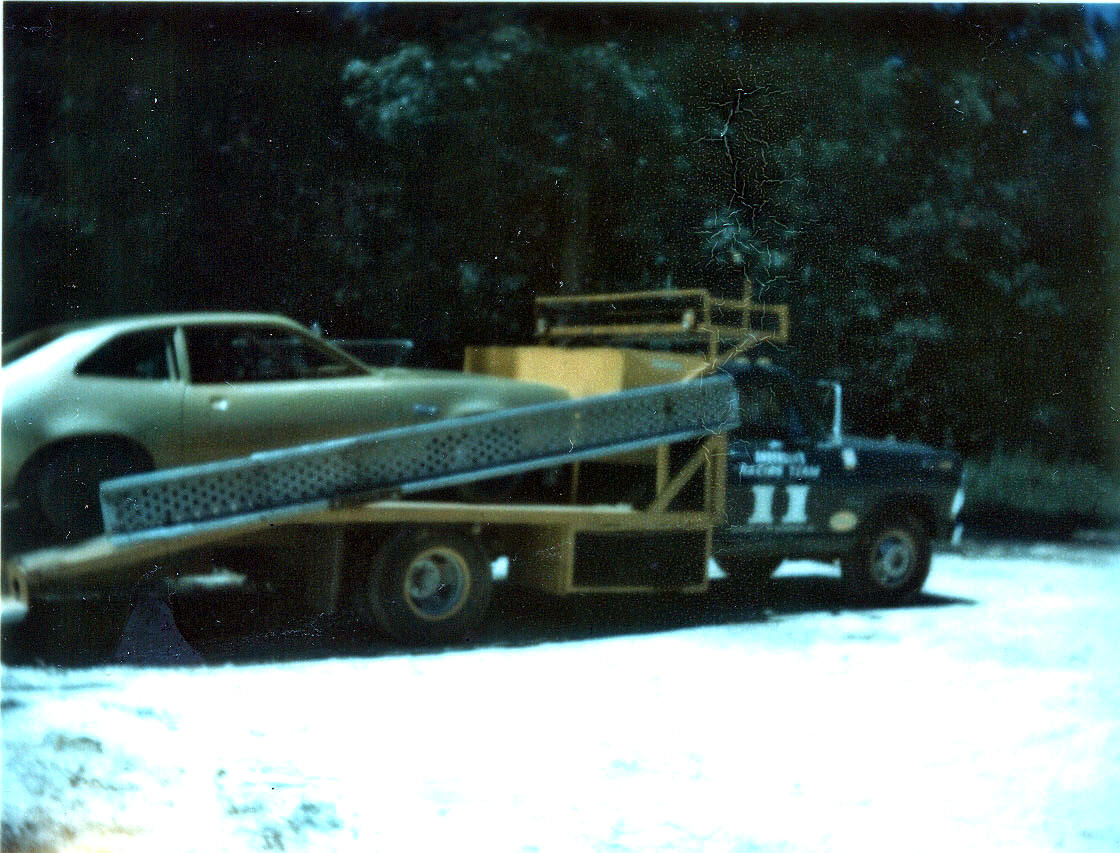
Courtesy of Jack Anderson
[Above] Jack's nifty
hauler is seen not only in my photos above but with the Baby Grand Pinto down
South. His Grand Touring, with Jim Van Diver, is seen below.
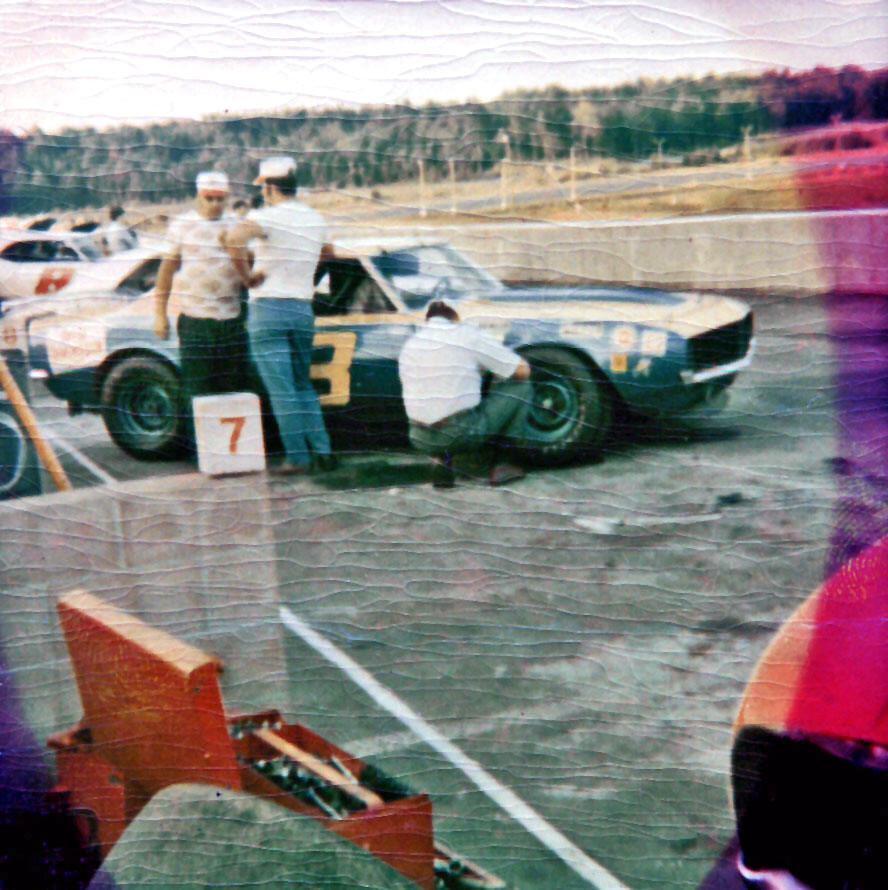
Courtesy of Jack Anderson
Today, Jack belongs to the Living Legends of Auto Racing, a group that I would
hope would have welcomed Wendell Scott had he lived that long. Jack sends
occasional photos of himself with well – known racing personalities or with him
driving a restored race car of one sort or another. Perhaps he could get someone
to help him reproduce that infamous Chevelle convertible hybrid late model
sportsman he had for a brief spell at Catamount Stadium around 1974.
I know I miss not seeing Jack more frequently and I certainly miss the existence
of wonderful racing figures like Wendell Scott. I tried to find a photo of the
two together, and – knowing Jack – one probably exists.
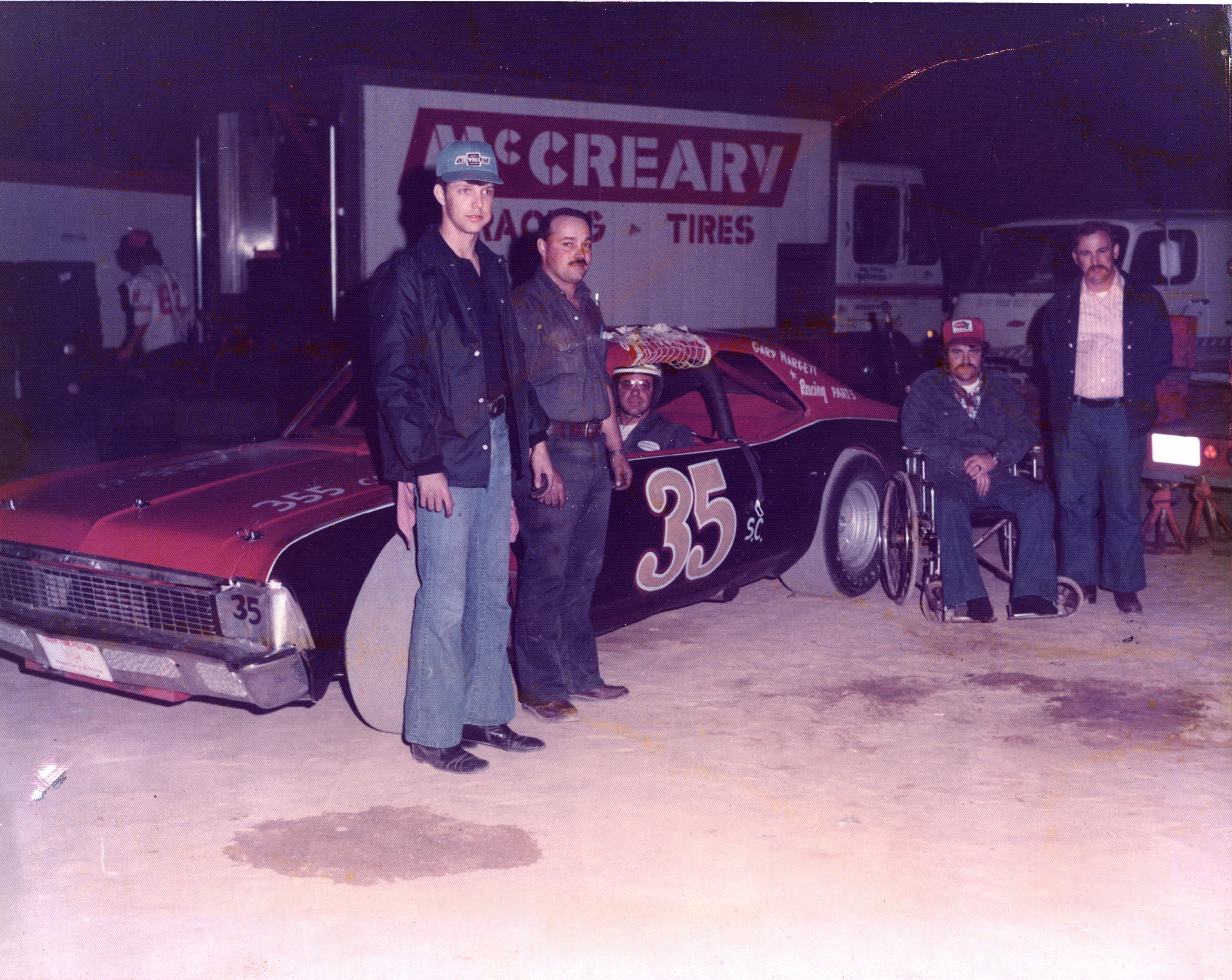
Keith Smith Photo via Jack Anderson
Jack drove the
Harget – owned 35 SC in the South after he had wrapped up his Chevelle period up
with Northern NASCAR. Below – Jack [left] and Tom Tiller [right joined George
Chates who went to visit the highly popular Stub Fadden in North Haverhill, NH
after Stubby was stricken with a stroke.
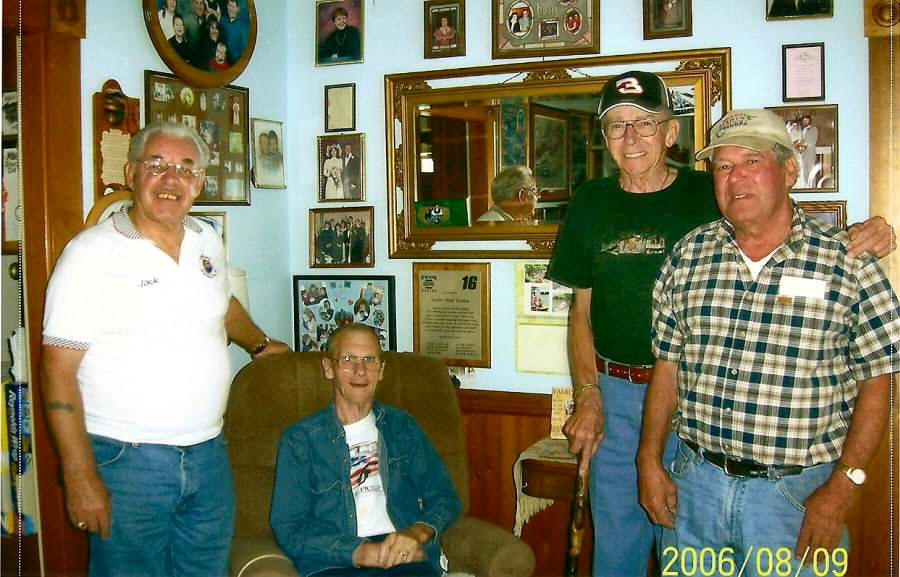
Courtesy of Jack Anderson
Please email me if you have
any photos to lend me or information and corrections I could benefit from.
Please do not submit anything you are not willing to allow me to use on my
website - and thanks. Email is:
wladabou@comcast.net . For those who still don’t like computers - my
regular address is: Bill Ladabouche, 23 York Street, Swanton, Vermont 05488.
AS ALWAYS, DON’T FORGET TO CHECK OUT MY WEBSITE
www.catamountstadium.com
Return to the Main Page
Return to the Main News Page
Return to the All Links Page
Return to the Weekly Blog Links Page









 |
|











